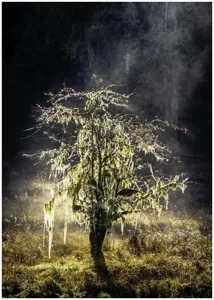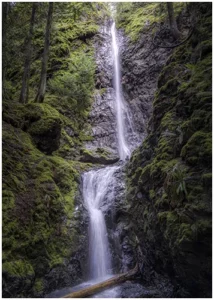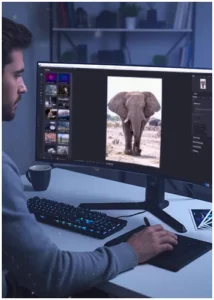
Dealing with Harsh Light in Landscape Photography
Yes, we all know that shooting in harsh light is taboo, and this sounds a


Did you know that over 3.8 trillion photos have been taken since the invention of photography? With the advancement of smartphones and digital cameras, photography is everywhere. Whether you’re taking a quick selfie or breathtaking landscapes, understanding the concepts of photography can elevate your skills and help you create stunning images.
In this section, we will explore the art of photography and its transformation over time. We will explore the importance of photography in today’s world, emphasizing its role as a powerful way to tell stories, express oneself, and communicate.
The art of photography has come a long way since its inception. From the early days of glass plates to the digital era of today, photography has undergone a remarkable evolution. With AI integration, this trend continues, enhancing capabilities and streamlining our workflow, ensuring photography remains dynamic and accessible. Technology has revolutionized the way we capture, modify, and share photos, unlocking endless possibilities.
With the arrival of DLSRs, mirrorless cameras, and smartphones, photography is more accessible than ever before. The ability to instantly view and edit photos has revolutionized our approach to photography, empowering us to experiment and improve.
Moreover, the rise of social media platforms and online photo-sharing communities has given photographers a global platform to showcase their work and connect with fellow enthusiasts. This transformation has empowered individuals from all walks of life to express their creativity through fine art photography and share their unique perspectives with the world.
In today’s visually driven society, photography plays a pivotal role in capturing moments, preserving memories, and conveying emotions. It serves as a universal language that transcends barriers of language and culture, allowing us to connect with others on a deeper level.
It has the ability to stimulate thought, emotion, and inspiration. It can shed light on social issues, raise awareness, and spark conversations. Through the lens of a camera, photographers can capture the beauty, diversity, and complexities of the world we live in, encouraging us to see things from different perspectives.
Furthermore, photography serves as a medium of self-expression, enabling individuals to share their unique stories, experiences, and viewpoints. It allows us to document our personal journeys, express our creativity, and leave our mark on the world.
Photography ideas continuously evolve, shaped by cultural changes, technological progress, and shifting values. As photographers, we have the power to capture the essence of the human experience and shape the way we perceive the world around us.
| The Art of Photography | Transformation of Photography | Photography in Today's World | Photography Ideas |
|---|---|---|---|
| Explores the creative aspects of photography | Traces of the evolution of photography over time | Highlights the significance of photography in today's society | Promotes innovative and unique concepts in photography |
| Emphasizes artistic expression through photography | Discusses the impact of technology on the art form | Explores the ability of photography to tell stories and connect people | Encourages photographers to think outside the box and push boundaries |
| Encourages experimentation and creativity | Examines the changes in photography techniques and equipment | Highlights the role of photography in capturing emotions and experiences | Offers fresh perspectives and inspiration for photographers, especially in conceptual art and different types of photography |
| Provides insights into different genres and styles of photography, including conceptual art, fine art, and abstract | Showcases the advancements in post-processing and editing | Explores photography as a means of self-expression and storytelling | Promotes the utilization of new technologies and automatic mode in modern cameras |
The industry standard for photo enlargement is getting better. Download your free trial today!
In this section, we will explore the essential terms and concepts that are fundamental to understanding photography. These concepts form the building blocks of your photographic knowledge and will serve as a solid foundation for your future exploration and growth in this art form.
Aperture, shutter speed, and ISO are three key elements that contribute to the exposure of your photographs, affecting the image noise and sharpness. Understanding how they work together will allow you to have full control over the outcome of your images.
Aperture refers to the opening of the lens through which light passes into the camera. It determines the depth of field, or the range of focus in an image, which is greatly influenced by the amount of light the shutter is open to. A wider aperture (smaller f-number) will create a shallow depth of field, whereas a narrower aperture (larger f-number) will result in a greater depth of field.
Shutter speed refers to the length of time that the camera’s shutter remains open, allowing light to reach the light-sensitive image sensor. It determines the amount of motion blur in your photos and is crucial for capturing moving subjects. A faster shutter speed freezes action, indicating a short duration while the shutter is open, while a slower shutter speed creates motion blur, showing a longer duration of exposure.
ISO measures the sensitivity of the camera sensor to light. A higher ISO setting (such as 800 or above) allows you to capture images in low-light situations, but it may introduce noise or graininess into your photos. On the other hand, a lower ISO such as 100 or 200 results in less noise but requires more light.
Composition, a crucial concept in any type of photography, is the arrangement of elements within the frame of your photograph. It is an essential aspect of creating visually pleasing and impactful images. Understanding composition allows you to guide the viewer’s eye and convey your intended message effectively.
The rule of thirds is a compositional guideline that divides the frame into a grid of nine equal parts using two horizontal and two vertical lines. The idea is to place the key elements of your image along these lines or at their intersections. By doing so, you create a balanced and visually appealing composition that draws the viewer’s attention.
By grasping these basic photography terms and concepts, you will have the knowledge and skills needed to take control of your camera’s settings and create well-composed images. Let’s now explore how to build your photography toolkit to further enhance your creative journey, incorporating post-production tools like Adobe Photoshop, Luminar Neo or On1 to refine your images.
In order to excel in photography, having the right set of tools is crucial. Building a photography toolkit involves acquiring essential camera gear, like cameras’ lenses, and the right photography accessories to enhance your craft.
When starting your photography journey, investing in the right camera gear is essential. Here are a few must-have items:
By having these essential items, you’ll be well-equipped to start your photography journey.
In addition to camera gear, photography accessories can greatly enhance your creativity and the quality of your pictures. Consider investing in these accessories:
These photography accessories designed for modern cameras will expand your creative possibilities and enable you to capture professional-looking images.
Once you’ve taken the picture, the journey doesn’t end there! You may not like this, but post-processing is part of the profession. There are a plethora of editing programs on the market. Software like Skylum Neo or On1 Raw offers tools to enhance colours, correct exposure, and remove imperfections.
With user-friendly interfaces and plenty of online tutorials, these software options are accessible even for beginners. Experimenting with post-processing can add your unique touch to each image, making them truly stand out. Don’t forget to explore the world of editing software; most have 30-day trials, and there are literally dozens to choose from.
One of the most crucial aspects of photography is understanding the role of light and shadow. As a photographer, having a keen eye for how light interacts with your subject is especially crucial in light-sensitive settings and can significantly enhance the quality and impact of your photos. The way light falls on a scene can create depth, texture, and dimension, giving life to your photographs.
When photographing outdoors, pay attention to the direction and intensity of the light. During the golden hour, which occurs shortly after sunrise or before sunset, the soft, warm light can add a magical touch to your images. Experiment with different angles and perspectives to find the most flattering light for your subject. Similarly, capturing images in challenging lighting conditions, such as during midday or in low light, can also yield unique and striking results.
Furthermore, shadows play a crucial role in photography, adding contrast and drama to your compositions. By intentionally incorporating shadows into your images, you can create more dynamic and visually interesting photos. Experiment with the interplay between light and shadow, using them to highlight specific details or to create a sense of mystery and intrigue.
Photography goes beyond simply capturing beautiful landscapes or epic moments; it serves as a powerful medium for conveying emotions and narrating stories. As a photographer, your skill in capturing the essence of a moment and expressing the emotions will set your work apart.
Seeking inspiration in everyday scenarios can help you develop a unique perspective and create more meaningful photos. Look for the hidden beauty in ordinary things, observe the small details that often go unnoticed, and capture the fleeting moments of joy, sadness, or contemplation through the lens of conceptual art.
Take the time to connect with your subjects or environments; allowing yourself to feel the emotions that surround you is an essential practice in the concept of photography. Whether it’s capturing a child’s innocent laughter, a melancholic sunset, or the intense concentration on a musician’s face, photographs that evoke emotions have the power to resonate deeply with viewers.
Remember, inspiration can be found anywhere, from bustling city streets to serene natural landscapes. Train yourself to see beyond the surface and the obvious, allowing your photographer’s eye to discover and capture the emotions that make a moment truly special.
| Developing Your Photographer's Eye Key Points | Techniques and Conceptual Photography Ideas | Benefits |
|---|---|---|
| Recognize the role of light and shadow | Experiment with different lighting conditions, angles, and perspectives | Create depth, texture, and dimension in your images; add drama and contrast with shadows |
| Find inspiration in everyday scenarios | Observe the small details and fleeting moments; connect with your subjects | Create more meaningful images that evoke emotions and tell stories |
Looking to stretch your budget? Save 43% with Back to School. Plus 10% when you use code bwild10
In this section, you’ll discover advanced photography techniques that help you take your skills to the next level. By exploring different photographic styles and embracing creative challenges, you can push the boundaries of your creativity and capture images that stand out.
Photography is a versatile art form that offers a wide range of styles to explore. By experimenting with different styles, you can find your niche and develop a unique visual identity. Here are a few popular photographic styles to consider:
To master each style, study the work of renowned photographers in that genre, analyze their techniques, and experiment with different compositions, lighting techniques, and post-processing methods. By immersing yourself in different styles, you can expand your artistic repertoire and develop a unique visual voice.
Great photographers are constantly challenging themselves to push their boundaries. By embracing creative challenges, you can break free from your comfort zone and discover new perspectives.
Here are a few challenges to consider:
By embarking on these creative challenges, you will not only improve your technical skills but also develop a deeper understanding of your own creativity. Embrace the opportunity to step outside your comfort zone and let your imagination soar.
In order to further enhance your photography skills and immerse yourself in the vibrant photography community, it’s essential to explore various resources that offer opportunities for growth. From must-read books and online photography courses to groups and competitions, there are countless avenues to expand your knowledge of different types of photography and connect with fellow photographers.
One of the best ways to deepen your understanding of photography is by diving into the wealth of knowledge available in books and online courses. Whether you’re a beginner looking to grasp the basics or an experienced photographer aiming to refine your techniques, there are resources tailored to every skill level and interest.
Some highly recommended books for photographers include:
These books provide valuable insights into various aspects of photography, including composition, exposure, and storytelling.
When it comes to online tutorials, platforms like Udemy, and Skillshare offer a wide range of courses taught by industry experts. From technical skills such as mastering aperture and shutter speed to creative techniques like portrait lighting and post-processing, you can find courses that cater to your specific interests and learning style.
A strong sense of community can significantly enrich your photography journey. By joining photography groups, whether online or in your local area, you’ll have the opportunity to connect with fellow photographers, share knowledge, and receive constructive feedback on your work. These groups often organize meetups, workshops, and photo walks, which can be great occasions to learn from others and gain inspiration.
Another way to engage with the photography community is by participating in photography competitions, a vital aspect of photography that requires active involvement. These competitions provide a platform to showcase your work, gain recognition, and gain valuable feedback from judges and fellow photographers. Whether it’s a local competition or an international contest, the experience of submitting your photos and seeing them displayed alongside the work of other talented photographers can be immensely rewarding.
Remember, the photography community is both supportive and diverse, offering opportunities for collaboration and learning from photographers with different backgrounds and perspectives. Embrace these resources and connections to fuel your passion and continuously evolve as a photographer.
In conclusion, this article has provided a comprehensive overview of the fundamental concepts and techniques of photography. Throughout the sections, we have explored the evolution of photography, its role in today’s world, and the importance of understanding basic photography terms and composition. We have also discussed the essential camera gear and accessories that can enhance your craft, as well as techniques to develop your photographer’s eye and elevate your skills.
By delving into various photographic styles and pushing your creative boundaries, you can continue to grow as a photographer and capture awe-inspiring images. Additionally, we have highlighted the resources available, such as must-read books and online courses, as well as the significance of joining photography groups and participating in competitions to expand your knowledge and connect with like-minded individuals.
Armed with the knowledge and inspiration gained from this article, it’s time to embark on your photography journey and continue honing your skills. Remember, photography is not only about holding a camera; it is about capturing moments, telling stories, and expressing your unique perspective. So, grab your camera, explore your surroundings, and let your creativity soar!
What is the best camera for beginners? The best camera for beginners depends on individual preferences and needs. Entry-level DSLRs like the Canon EOS Rebel T7 or mirrorless cameras such as the Sony Alpha a6000 are popular choices, offering ease of use and versatility for budding photographers.
Improve photo sharpness by adjusting focus settings, using a tripod, choosing an optimal aperture, and ensuring proper lighting conditions. Explore the benefits of using manual focus to achieve ultimate precision. Enhance post-processing techniques for clarity and experiment with different ISO speeds. Explore lens options for sharper results.
Discover fundamental photography concepts, including exposure, composition, lighting, and perspective. Dive into aperture, shutter speed, ISO, rule of thirds, conceptual photography ideas, and more. Explore how to capture stunning images with expert tips and techniques.

Yes, we all know that shooting in harsh light is taboo, and this sounds a

As a passionate waterfall photographer, I’ve discovered that exposure time and amount of light, be

Do you remember that perfect shot you took? But then, post-processing was a struggle? You’re